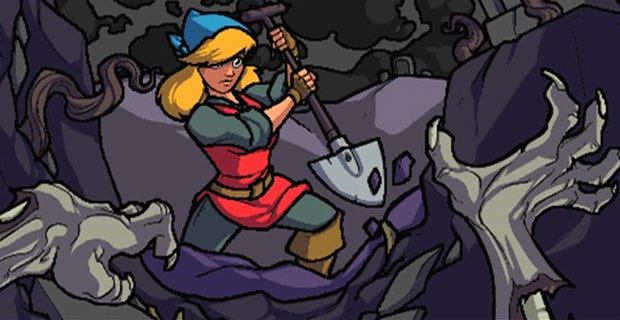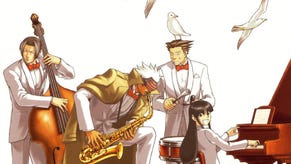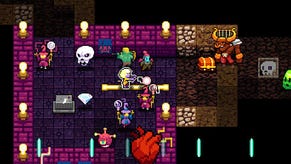Impressions: Crypt of the Necrodancer
Dancing with death
Crypt of the Necrodancer blends roguelikes with rhythm action, neatly makes that wild concept work, and is out on Early Access today. I’ve been dipping my twitching toes in and out of it for the last couple of weeks.
I’ve long been aware of my own challenging relationship with rhythm – although I did take a certain pride in people moving away from my frenzied, unpredictable whirling in clubs – but struggling to cope with even Crypt of the Necrodancer’s sound latency calibration tool was a blow. I stared at the blinking icons and listened to the test tone I couldn’t seem to predict, gripped by professional terror. Somehow I’d decided it was a great idea to write about a game based on rhythm. Now, excuses rushes through my brain. "I damaged both my index fingers while making a sandwich." "My middle ear blew because my baby screamed too loud." "It turns out I’m allergic to the word ‘crypt."
None were needed. That calibration test was no harbinger of doom after all. I lost myself to the rhythm, to the broadswords and to disco skellingtons. Sometimes I even managed to move in time with the beat.
In a big way, Crypt of the Necrodancer’s elevator pitch says all that need be said about it. It’s a rhythm-action roguelike. You dance through a dungeon, you dance into combat, you even dance into shops to exchange gold for weapons and armour from a singing shopkeeper. The challenge Necrodancer always had was to live up to that pitch. Thank Moroder, it really does.
To move up, you tap up in time with the beat. To attack a Green Blob, you tap in its direction in time with the beat. To buy a golden dagger, you tap towards it in time with the beat. You tap. In time. With the… Beat. It feels good. It sounds good. Everything bounces, and the floor lights up in alternating coloured chequers like a movie-eye view of a 70s NYC club.
My redemption came not so much from growing familiar with the songs (though you can add custom MP3s instead) or simply clicking into the groove after early stumbles, but from finding that getting better at the game is as much a matter of learning the game’s rules, creatures and abilities as it is moving fingers or feet to the beat.
Stuff like knowing that, if you don’t stab it first, you’ll end up with a monkey on your back and will need to clobber it four times before you can fight anything else. Stuff like knowing that a broadsword will attack diagonally. Stuff like oh God no don’t touch that whatever you do. Stuff like "do not panic if a massive green dragon appears, because actually all you need to do is hold your nerve for a few seconds."
Dance dance dungeoneering or no (and, indeed, evident Zelda visual cues or no), Necrodancer’s true inspiration is Spelunky. Derek Yu’s precision dungeon-runner is very much the game designer’s game in terms of its raft of clear but unyielding rules, rewarding those who practice patience and observation. Necrodancer might be a little bit more of a party animal (it’s certainly made with having an audience in mind – this is chasing the Twitch crowd, though it’s not visibly compromised itself to do so) but I haven’t seen anything in it so far that doesn't have a bloody good reason to be there.
Every enemy behaves slightly differently, every one-shot spell requires experience with it if it’s to have any kind of effect, and even most pieces of scenery require knowledge or appropriate tools. This isn’t Big Barry’s Wheels Of Steel – this is a DJ who’s actively studied how to fill a dancefloor. Even to the point, as I experienced, that the most self-conscious two-left-feeters can’t help but throw a shape or six.
I would say that it’s less naturally, or at least less stealthily, doing what it does than Spelunky did. It’s a little too easy to imagine someone saying "we have to include x and y, or look like z, because that’s what the kids expect" but I wouldn’t say that it tumbles into outright cynicism. Daft, deft little touches like the aforementioned sonorously yodelling shopkeepers or floor switches that temporarily double the tempo weave into a game that genuinely seems to be enjoying itself.
It has some great, great music too. I’d expected to be immediately plugging in my own tunes, but the official soundtrack fits so well –both in terms of pressing my buttons and making me press the game’s buttons correctly – that it would be a shame to. There’s a great deal of commercial science in Nerodancer’s bouncing bones, but it’s tempered by clear joyfulness.
As for plugging in other music, it is my sad duty to report that attempting to repeat the Great Kate Bush / Audiosurf War Of 2007 is not going to be successful. This requires DISCO. Or something with a big, brash beat, at least. If Audiosurf was a game to enhance music-listening, Necrodancer is about using music to enhance game-playing. Use it with the songs that make you dance, and I am quite sure you’ll play it better as a result.
Crypt of the Necrodancer is out on Early Access now, and to be honest I suspect it could have gotten away with being a full release (albeit with content patches to follow). It’s in good, sturdy shape, it’s slick and it lives up to its sky-high concept. I like it a lot. I like it enough that I’m going to do a self-shaming follow-up piece about playing it with a dance mat very soon.





















